New insect photos from our garden. / Neue Insektenfotos aus unserem Garten.
English
Hi insect fans! Again I have collected enough new pictures of insects and a spider to be able to publish another post for our "Fascinating Insects" community.
I hope you enjoy the photos and like some added information about these little creatures! :)
Deutsch
Hallo Insektenfans! Mittlerweile habe ich wieder genug neue Bilder von Insekten und einer Spinne gesammelt, um einen weiteren Beitrag für unsere "Fascinating Insects"-Community veröffentlichen zu können.
Ich hoffe, euch gefallen/interessieren die Fotos sowie einige zusätzliche Informationen über diese kleinen Geschöpfe! :)
| The magnificent flowers of the 'great scarlet poppy' (Papaver bracteatum) attract many different bees and bumblebees, but today I would like to show you that also stems and foliage are an obviously attractive habitat for a variety of insects. | Die prächtigen Blüten des 'Armenischen Mohns' (Papaver bracteatum) ziehen zahlreiche verschiedene Bienen und Hummeln an, aber heute wollte ich euch zeigen, dass auch Stängel und Blattwerk für Insekten aller Art ein offensichtlich attraktives Habitat darstellen. |
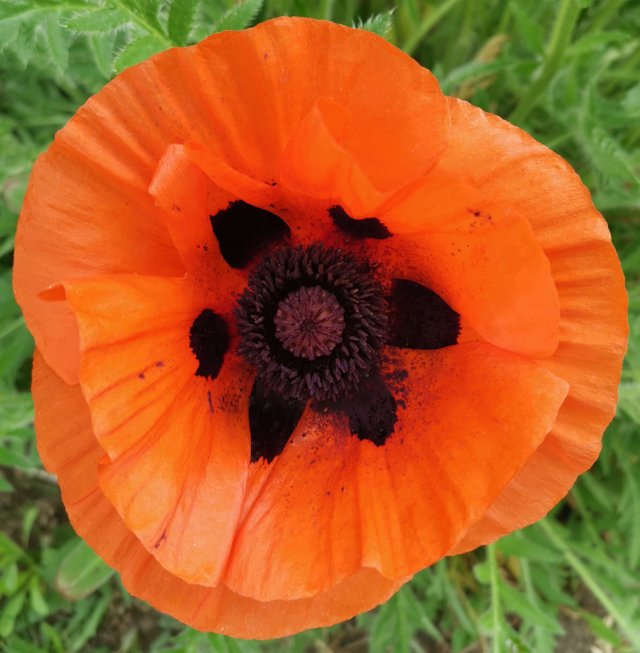
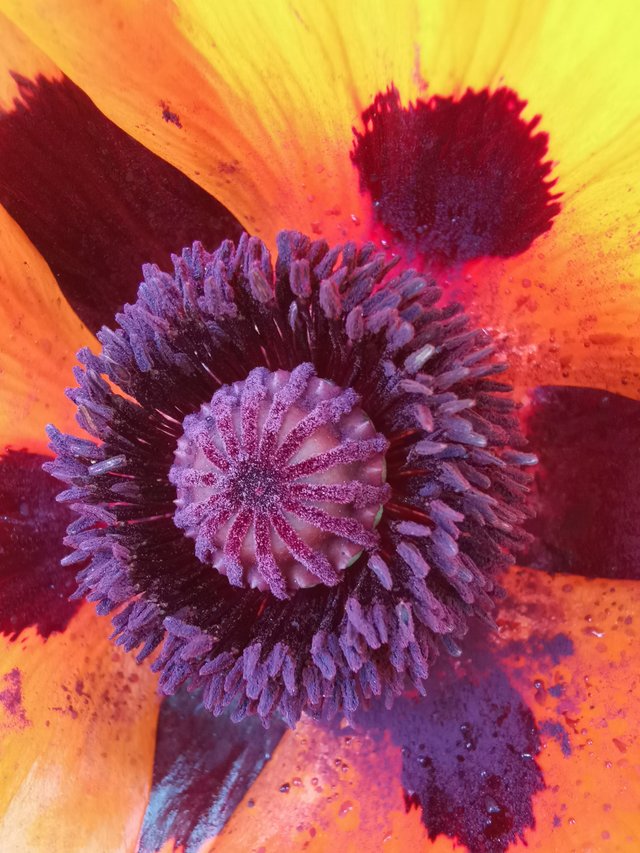
| Which red is brighter, that of the poppy blossoms or that of this 'red-headed cardinal beetle' (Pyrochroa serraticornis)? | Welches Rot ist leuchtender, das der Mohnblüten oder das dieses 'Rotköpfigen Feuerkäfers' (Pyrochroa serraticornis)? |
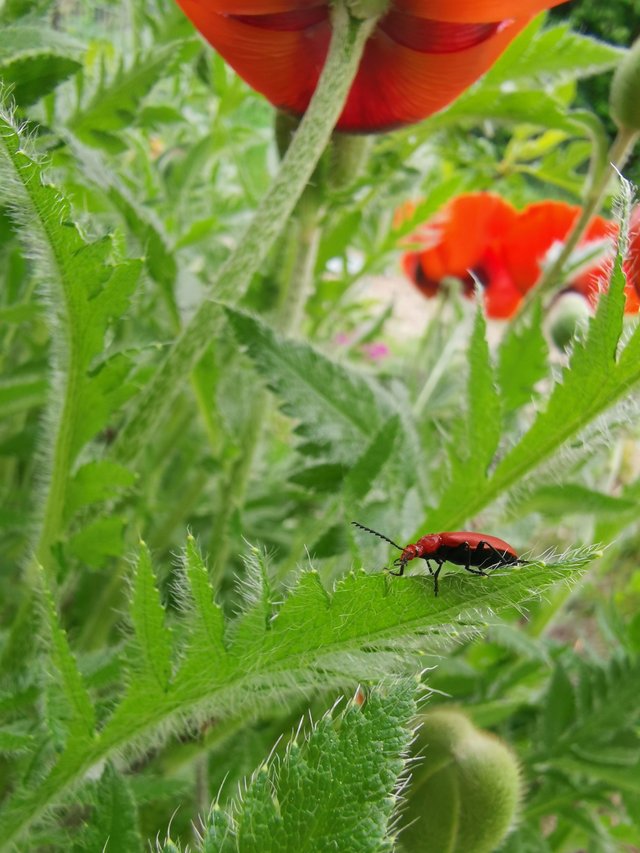
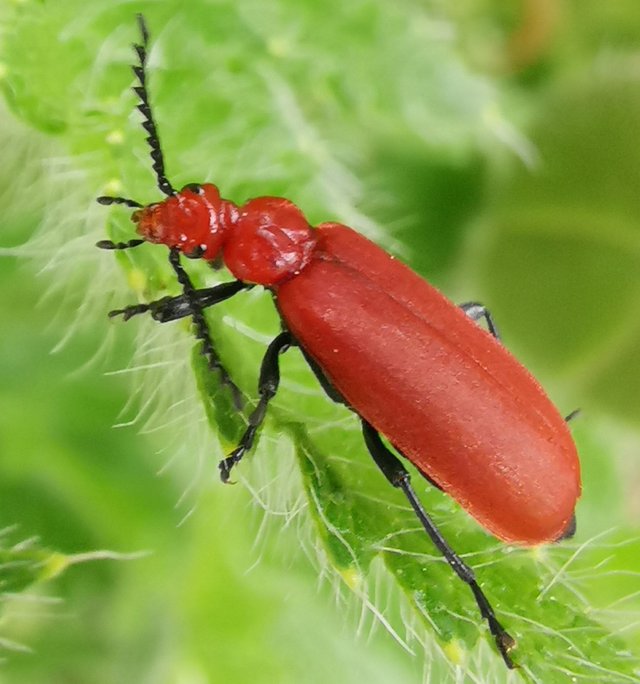
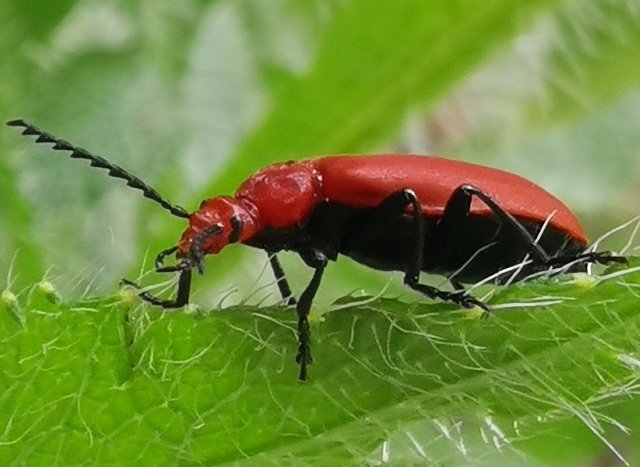
|
The thermophilic 'mottled shieldbug' (Rhaphigaster nebulosa), just like the poppy on which it sits, enjoys the first warm weeks of the year.
As with all bugs (whether phytophagous, like this species, or predatory) the mouth parts are designed as proboscis. |
Die wärmeliebende 'Graue Gartenwanze' (Rhaphigaster nebulosa) freut sich, genauso wie der Mohn, auf dem sie sitzt, über die ersten warmen Wochen des Jahres.
Wie bei allen Wanzen (egal ob phytophag, wie diese Art oder räuberisch) sind die Mundwerkzeuge als Saugrüssel ausgebildet. |
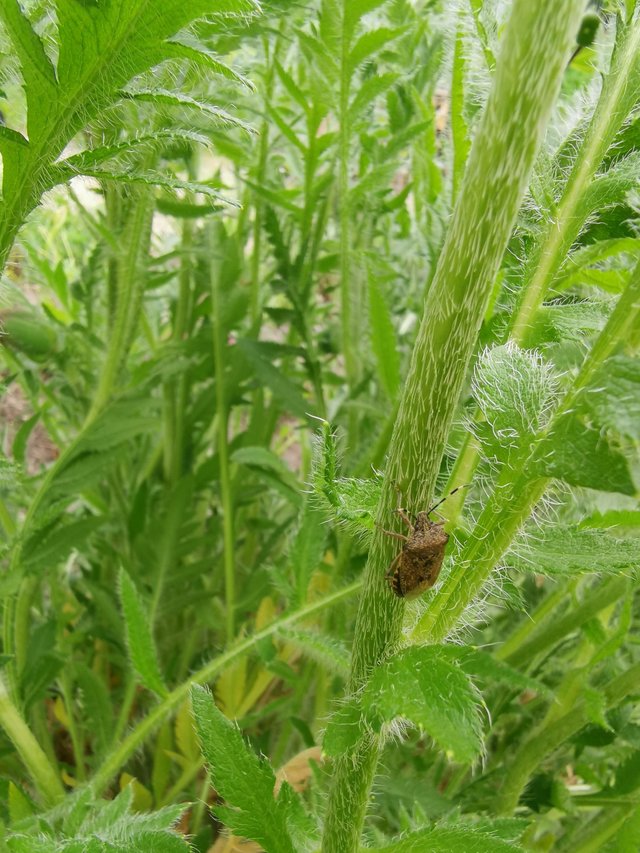
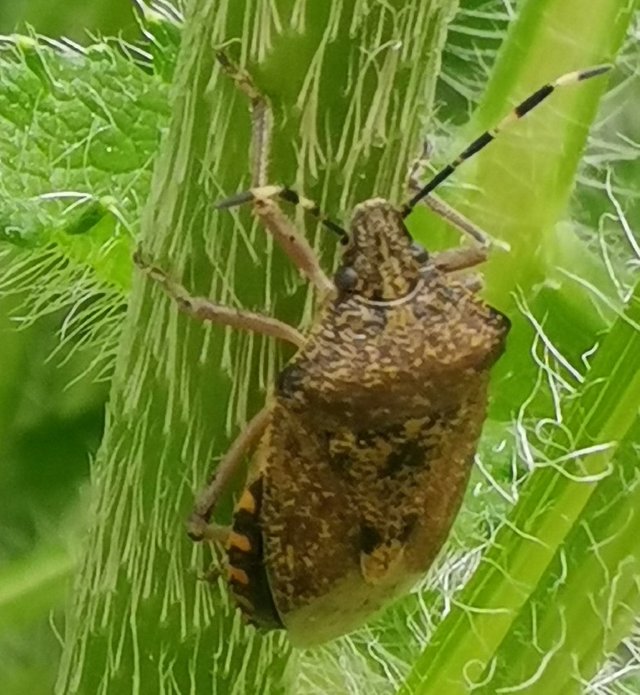
| Also this 'crab spider' (family Thomisidae) is hiding under the very hairy leaves of the large poppy plant. | Auch diese 'Krabbenspinne' (Familie Thomisidae) versteckt sich unter den stark behaarten Blättern der großen Mohnpflanze. |
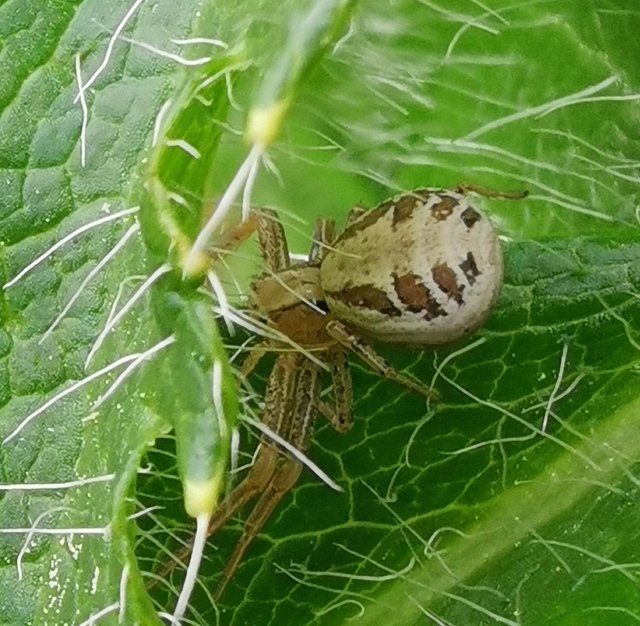
| These two 'soldier beetles' (Cantharis fusca) are copulating on a 'large-leaved lupine' (Lupinus polyphyllus). | Diese beiden 'Gemeinen Weichkäfer' (Cantharis fusca) paaren sich auf einer 'Vielblättrigen Lupine' (Lupinus polyphyllus). |
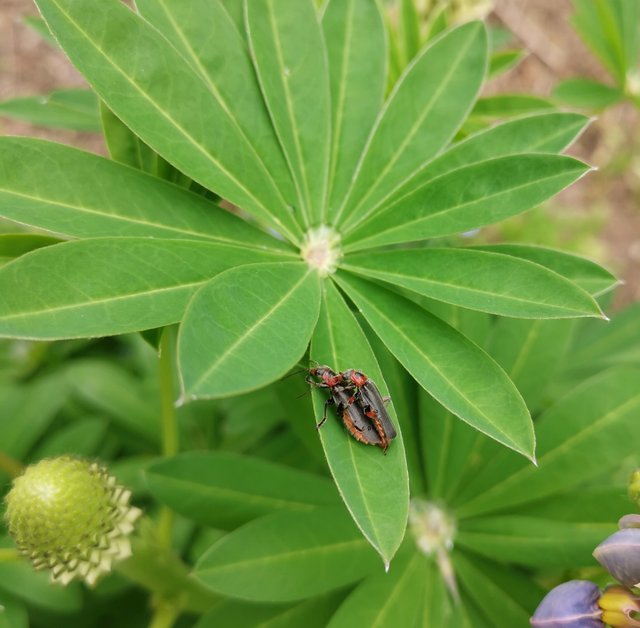
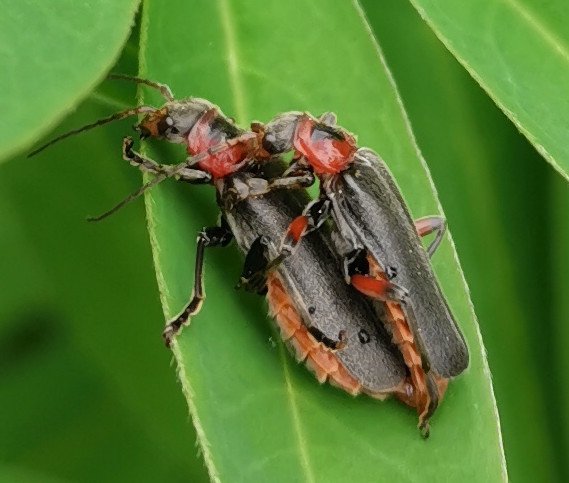
|
I found this still wingless nymph of the 'great green bush-cricket' (Tettigonia viridissima) on a dandelion flower in our garden.
Locusts belong to the hemimetabolic insects in which (in contrast to the holometabola, e.g. butterflies) the different nymph stages gradually become more and more similar to the adult insects (imagines) with each moulting. Like all species of the suborder Ensifera also the 'great green bush-cricket' has very long antennae. |
Diese noch flügellose Nymphe des 'Grünen Haupferds' (Tettigonia viridissima) fand ich auf einer Löwenzahnblüte in unserem Garten.
Heuschrecken gehören zu den hemimetabolen Insekten bei denen (im Gegensatz zu den holometabolen, z. B. Schmetterlingen) die verschiedenen Nymphenstadien den adulten Tieren (Imagines) mit jeder Häutung graduell immer ähnlicher werden. Wie auf dem Foto gut zu erkennen ist, gehört das 'Grüne Heupferd' zu den 'Langfühlerschrecken' (Ensifera). 'Langfühlerschrecken' würde DeepL übrigens mit 'long-distance horrors' übersetzen. :-) |
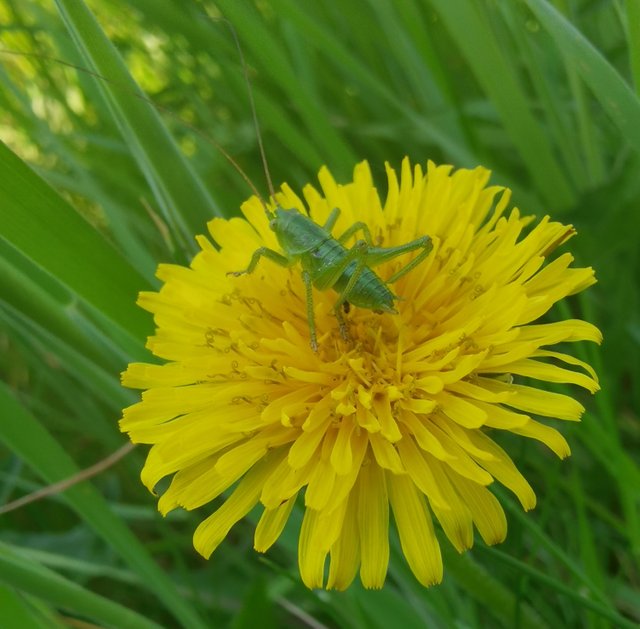
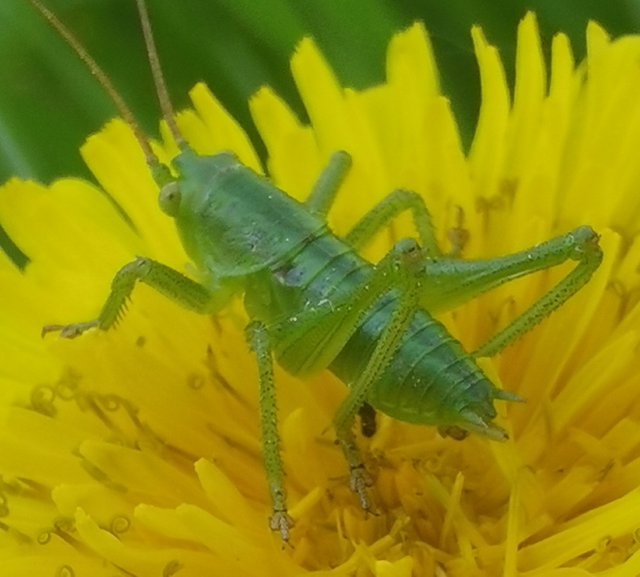
| Retrospectively I cannot determine this bug found on a 'dandelion' (Taraxacum sect. Ruderalia) with certainty. My guess is that it belongs to the subfamily of Mirinae. | Diese auf einer 'Pusteblume' (Taraxacum sect. Ruderalia) gefundene Wanzenart kann ich im Nachhinein nicht mehr sicher bestimmen. Ich tippe darauf, dass sie zur Unterfamilie der Mirinae gehört. |
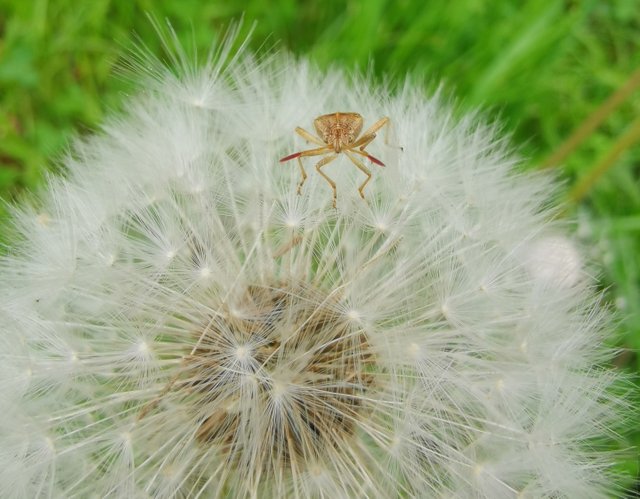
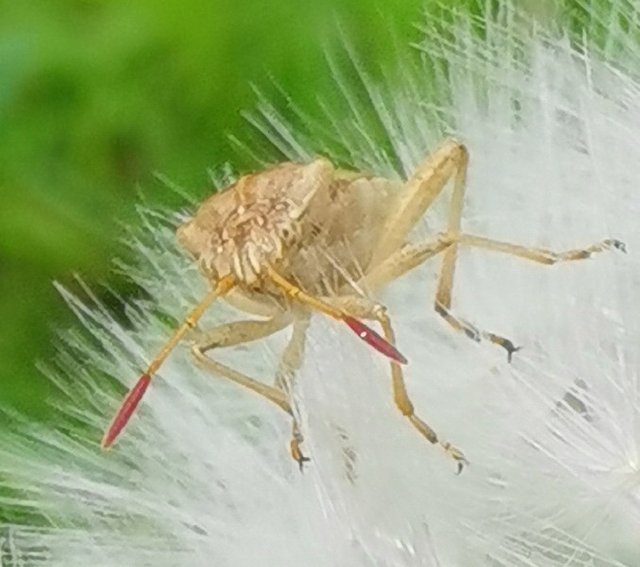
| "What are you looking at, curious Homo sapiens?" | "Was guckst du so, neugieriger Homo sapiens?" |
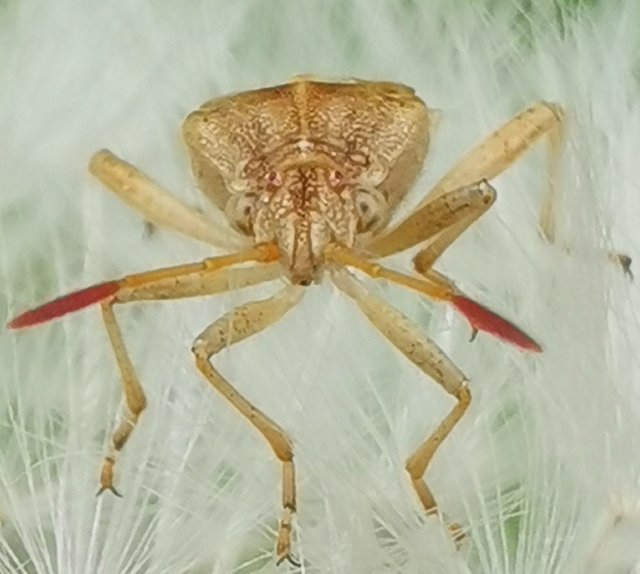
Wow, wieder beeindruckende Aufnahmen!
Diverse bunte Wanzen, Hummeln, Bienen, sogar die ersten Libellen treiben sich bei uns im Garten auch schon rum. Ich beobachte sie gern. Richtig faszinierend finde ich an deinen Bildern gerade die gestochen scharfen Härchen am Mohn, irre!
Jepp, ich WILL eine ordentliche Kamera... 😎
Schönen Sonntag euch,
LG Chriddi
Ich hoffte ja tatsächlich, irgendjemand würde auf meinen miesen Trick hereinfallen, die größtmögliche Mohnpflanze überhaupt (mit den entsprechend größtmöglichen Haaren) auszuwählen, um meine Bilder nach ganz besonders virtuoser Fotografenkunst aussehen zu lassen ... ;-)
"Was guckst du so, neugieriger Homo sapiens?"
Oft kann man so genau hingucken wie man will, mit oder ohne Brille, die Feinheiten sieht man doch erst beim Betrachten der Bilder, wenn sie so gestochen scharf sind wie die, siehe oben.
Haha, ich wollte nur mal die Perspektive umdrehen, da es vielen Lesern möglicherweise so erscheint, als 'glotze' die Wanze sie direkt an. :)
Wieder sehr starke Bilder von Dir! Bei den Nahaufnahmen der Insekten könnte man meinen man befindet sich in einem Alienfilm 😅
Die letzte Wanze sah ja mal richtig putzig aus, hätte mich jetzt auch interessiert, welcher Art dieser Winzling zuzuordnen ist. :)
Das war jetzt klar, dass dich genau die interessiert, die ich nicht bestimmen kann! :-)
Oh my goodness!
This is a wonderful gallery.
Each one is extraordinary.
They praise the creation, the nature, all a song.
Happy and long life.
Nice to read that you liked the pictures! :)
I love this world, every day they surprise us with a new gift. Beautiful shots and valuable information with which you complement. I am still learning. Greetings.
Sehr schöne Fotos. Und die Tiere sind sehr schön!
Beautiful photographs here @jaki01
Insects are really useful for the plants and wildlife but they must be controlled because they will eat the crops of farmers.
Birds will do that job for us in the other hand :D
Looked at it from our perspective some insects might be 'pests', but as every other organism they just try to survive and reproduce themselves. However, the real vermin of this planet is called Homo sapiens as he pollutes water and air, destroys the forests, produces plastic, emitts nuclear waste and leads wars ...
I think we humans should add more insects to our menu, too, as they are very healthy (full of proteins), numerous (with a high available biomass) and easy to farm.
I love poppies.
Thanks to @jasuly for burning 1000 CT! You have been rewarded with a 100% vote. Your action makes this project grow and helps to restore a Clean Planet! Join us on our Discord Channel and on our website